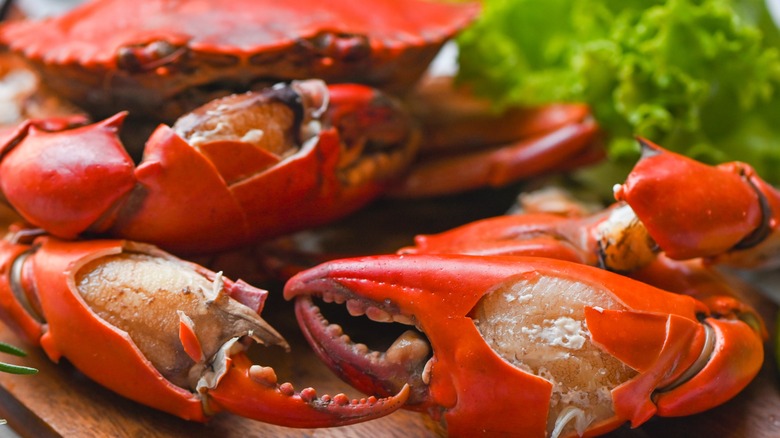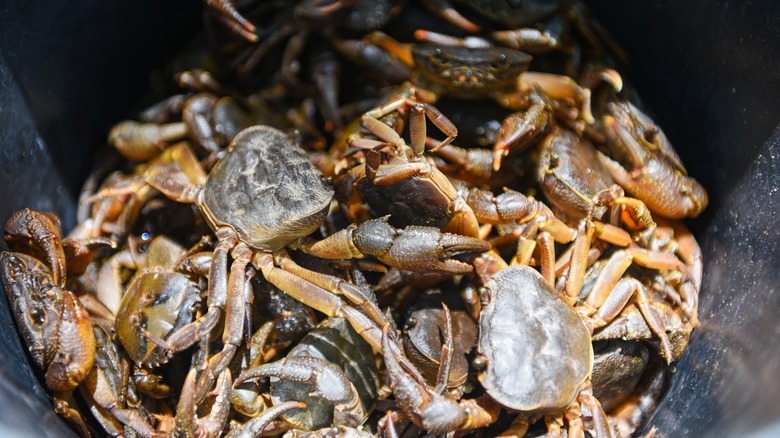Red Lobster Will Never Have 'Endless Crab' Because Of A Disastrous Trial Run
There are few experiences in the restaurant world that are as indulgent as the all-you-can-eat buffet. Sitting before you is an endless expanse of steaming chafing dishes and packed plastic receptacles, all of which are packed with piles of food. You can stride up and down the odorous aisles, picking the best bites from each container and assembling a perfect, heaping plate before stuffing your face with reckless abandon.
The American buffet, as we know it, emerged in the 1940s. In the years that followed, many restaurants followed suit. Today, you can enjoy an all-you-can-eat meal in every single U.S. state. Buffets are most commonly associated with cheap staples, but can the 'endless' model work when the food in question is a luxury? Red Lobster, a seafood chain that attempts to toe the line between casual restaurant and fine dining, once tried to offer an 'endless crab' promotion, to disastrous results.
Red Lobster underestimates the American appetite
Once you've started cracking into a plate of freshly cooked crab legs, it can be tough to stop. Red Lobster offered endless crab promotions for both the first and last time in 2003. For only $22.99, Red Lobster patrons could enjoy as many plates of crab and sides as their hearts desired. The generous offer certainly drew a lot of consumer attention, but Red Lobster was woefully underprepared for the indomitable appetite that American diners develop when presented with an all-you-can-eat opportunity.
People began to embark on marathon crab-eating journeys, with some dining parties scarfing down a veritable ocean trawler's worth of the succulent crustacean. To cope with the rapidly accumulating losses, some locations raised the price of the deal by several dollars. Nevertheless, the endless crab promotion proved devastating to Red Lobster's bottom line. The company's first-quarter earnings plummeted by millions, and its stock dropped by nearly three dollars a share.
Edna Morris was the Red Lobster president who oversaw the endless crab' promotion. However, she left the company after the disastrous trial run unfolded, though it's unclear if her departure from the company can be attributed solely to the shellfish fiasco.
The economics of all-you-can-eat crab
It's easy to understand how a limitless promotion could be taken advantage of. If consumer appetites exceed the bulk price of the food in question, the deal cannot be profitable. This is further exacerbated when the offer involves luxury items.
Shortly after the endless crab promotion flopped, The Tampa Bay Times interviewed restaurateur Frank Chivas, the proprietor of several Tampa seafood spots. Chivas explained that an endless crab promotion could only be profitable if the crustacean's wholesale price was $3.25 per pound, a price point that Chiva extrapolated his observation that the average person can crack into over two pounds of crab. At the time of the promotion, a pound of crab cost around $5.
The endless crab promotion also took a toll on the broader commercial crab industry. Crab is fished, not farms, so its supply is constantly shifting and limited. In 2003, the crab quota was low, so the price of the clawed critter was high. Red Lobster was also roundly critiqued by other businesses in the seafood sphere for buying up the bulk of North American crab supply to stock its locations for the influx of ravenous consumers.
Despite the endless crab promotion's utter failure, Red Lobster still offers all-you-can-eat deals. (However, the restaurant stays far away from crab). Currently, you can enjoy limitless shrimp, which comes in a variety of styles, every Monday for only $21.99.


